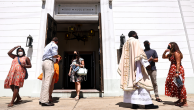Michael Rotolo contributed to this chapter.
The COVID-19 pandemic had an enormous impact on how religious communities gather for worship.
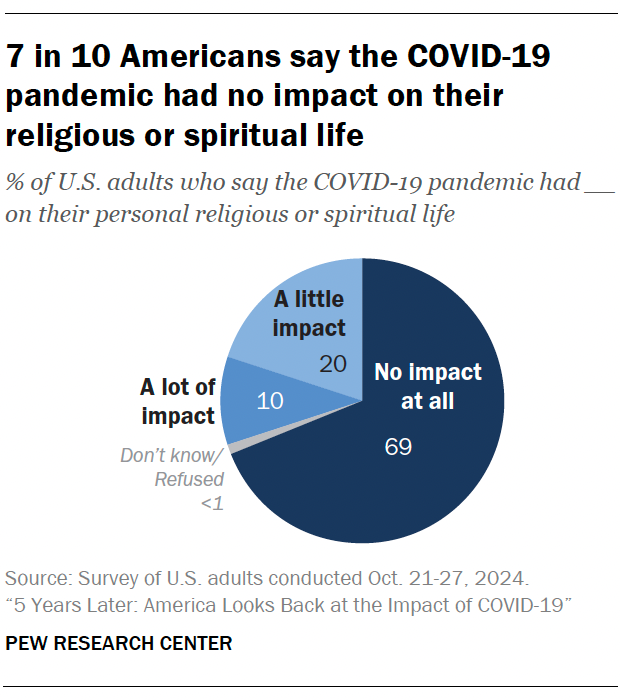
In a Pew Research Center survey in July 2020, a few months after the coronavirus struck the United States, just 6% of Americans who regularly attend religious services said their house of worship was open to the public and holding services in the same way as before the COVID-19 outbreak. The vast majority reported either that their house of worship was not open for in-person services (31%) or that it was open but with changes to limit the spread of disease (55%).
More than a year and a half later, in March 2022, fewer than half of regular worshippers (43%) reported that their church, synagogue, mosque or other house of worship had completely returned to normal, pre-pandemic operations.
Yet, despite COVID-19’s widespread effects on how houses of worship operate, most Americans say their religious and spiritual lives have not been changed by the pandemic, according to a Center survey conducted in October 2024.
Just 10% of U.S. adults report that the COVID-19 pandemic had a lot of impact on their religious or spiritual lives, while 20% say the pandemic had a little impact. About seven-in-ten Americans (69%) say the pandemic had no impact at all on their religious or spiritual lives.
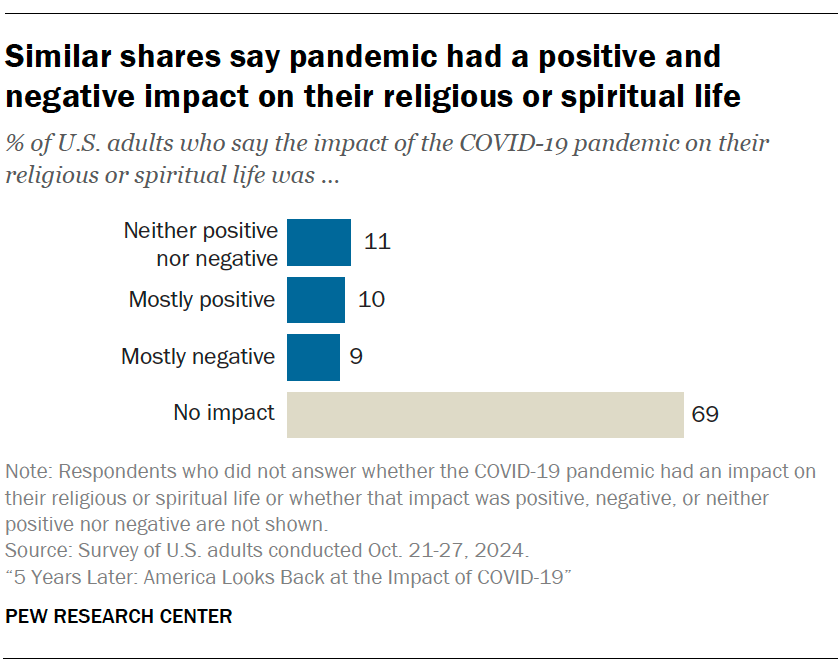
Among those who say their religious or spiritual lives were impacted, the pandemic’s effects appear to be a mixed bag: Roughly equal shares of U.S. adults say the pandemic’s effect on their religious or spiritual lives was mostly positive (10%), mostly negative (9%) and neither positive nor negative (11%).
Trends in religious service participation
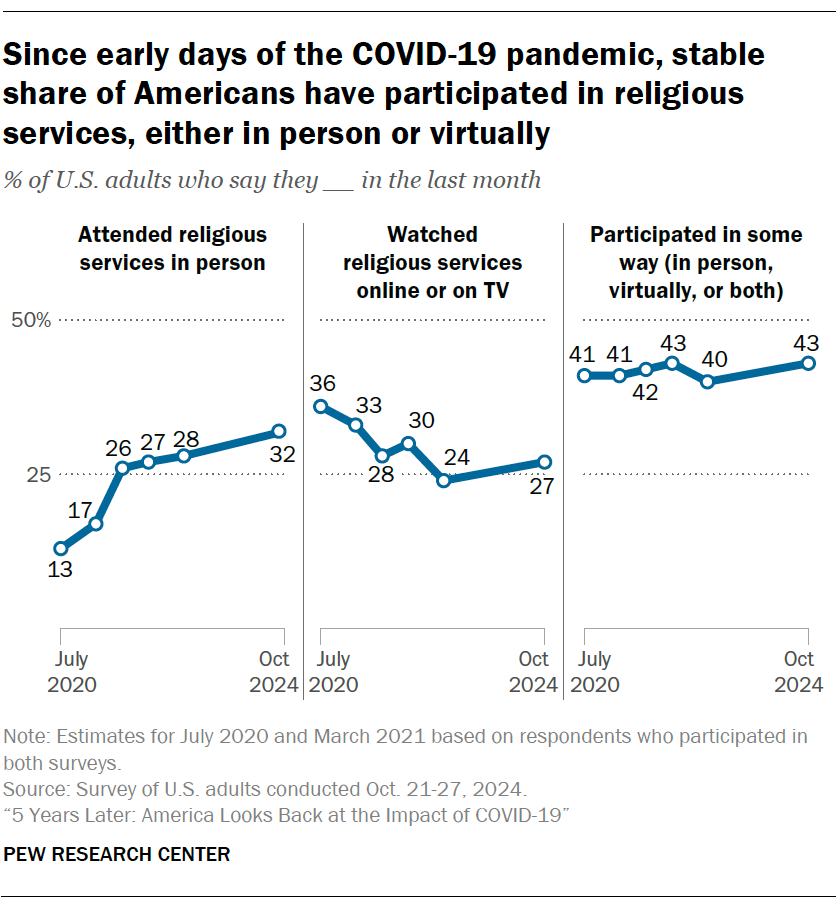
Throughout the pandemic, we periodically asked U.S. adults whether they had attended religious services in person in the prior month and, separately, whether they had participated virtually (either by streaming religious services online or by watching them on TV).
Since the early days of the coronavirus outbreak, the ways in which Americans participate in religious services have changed dramatically, with steadily rising numbers attending in person (and an overall drop in virtual participation) as the pandemic gradually receded.
Yet the percentage of U.S. adults taking part in religious services in some way – in person, virtually or both – has remained quite steady. In each of six surveys between 2020 and 2024, about 40% (or slightly more) of respondents reported that they had participated, one way or another, in services during the past month.
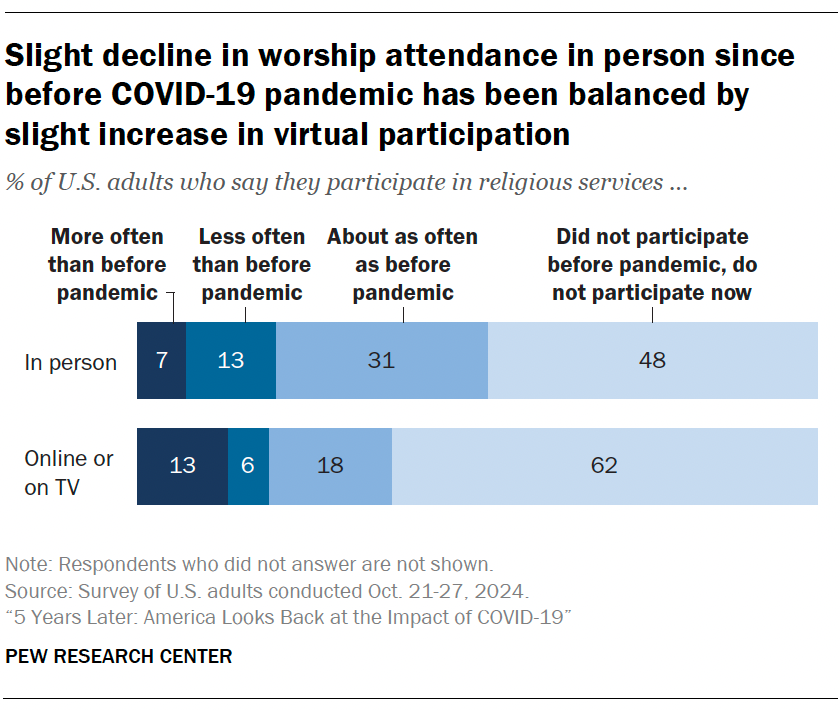
In the October 2024 survey, 32% of Americans say they attended religious services in person in the month prior to the survey, and 27% say they watched services online or on TV during the same period – both up slightly from the last time we asked these questions in November 2022.
The new survey also asked respondents whether they currently attend religious services in person more often, less often or about as often as they did before the pandemic. A second question asked the same thing about how often they watch services virtually.
The vast majority of U.S. adults say their religious participation habits have not changed:
- About eight-in-ten say either that they attend services in person about as often as they did before the pandemic (31%) or that they did not attend before the pandemic and still don’t (48%).
- Roughly eight-in-ten say either that they watch services virtually about as often as they did before the pandemic (18%) or that they didn’t watch services before the pandemic and still don’t (62%).
There may be a small net decrease in in-person attendance: 13% of Americans say they attend in person less often than they did before the pandemic, while just 7% say they now attend more often. But that difference is almost exactly offset by an increase in virtual participation: 13% of Americans say they watch services online more often than they did before the pandemic, while 6% say they now watch less often.
Together, these survey findings paint a picture of remarkable stability in U.S. religious life during a time of widespread upheaval in how houses of worship operate and despite a decades-long decline in religious affiliation and participation.3
The spiritual impact of the pandemic among religious groups and by race/ethnicity
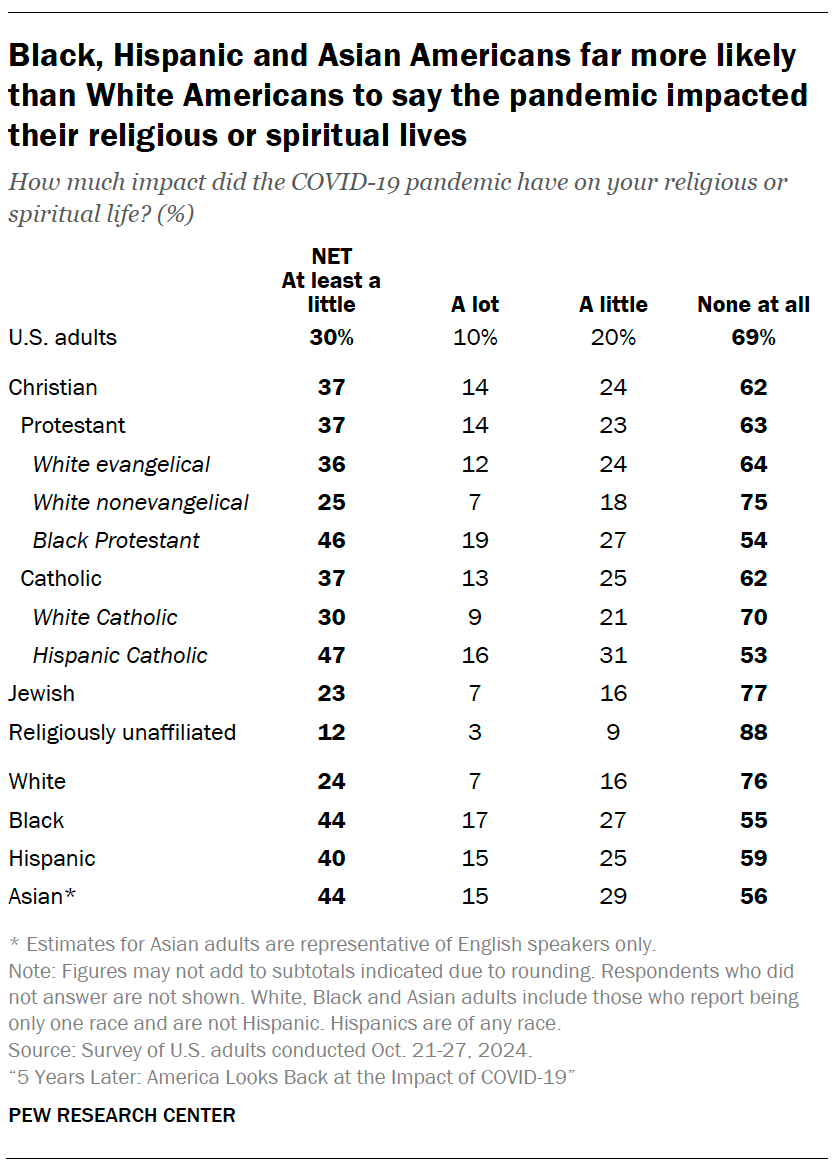
Black Protestants and Hispanic Catholics are more likely than some other large U.S. religious groups to say the pandemic affected their religious or spiritual lives. Nearly half of Black Protestants (46%) and Hispanic Catholics (47%) say the pandemic had at least a little impact on their religious or spiritual lives, compared with 30% of U.S. adults overall.
This appears to reflect a broader racial and ethnic pattern. Black Americans (44%), Hispanic Americans (40%) and Asian Americans (44%) are far more likely than White Americans (24%) to say the pandemic affected their religious or spiritual lives. These differences hold up even in statistical analyses that control for the effects of age, gender, education, political party, ideology, religious affiliation, income and region.
Among those who say their religious or spiritual lives were impacted by the pandemic:
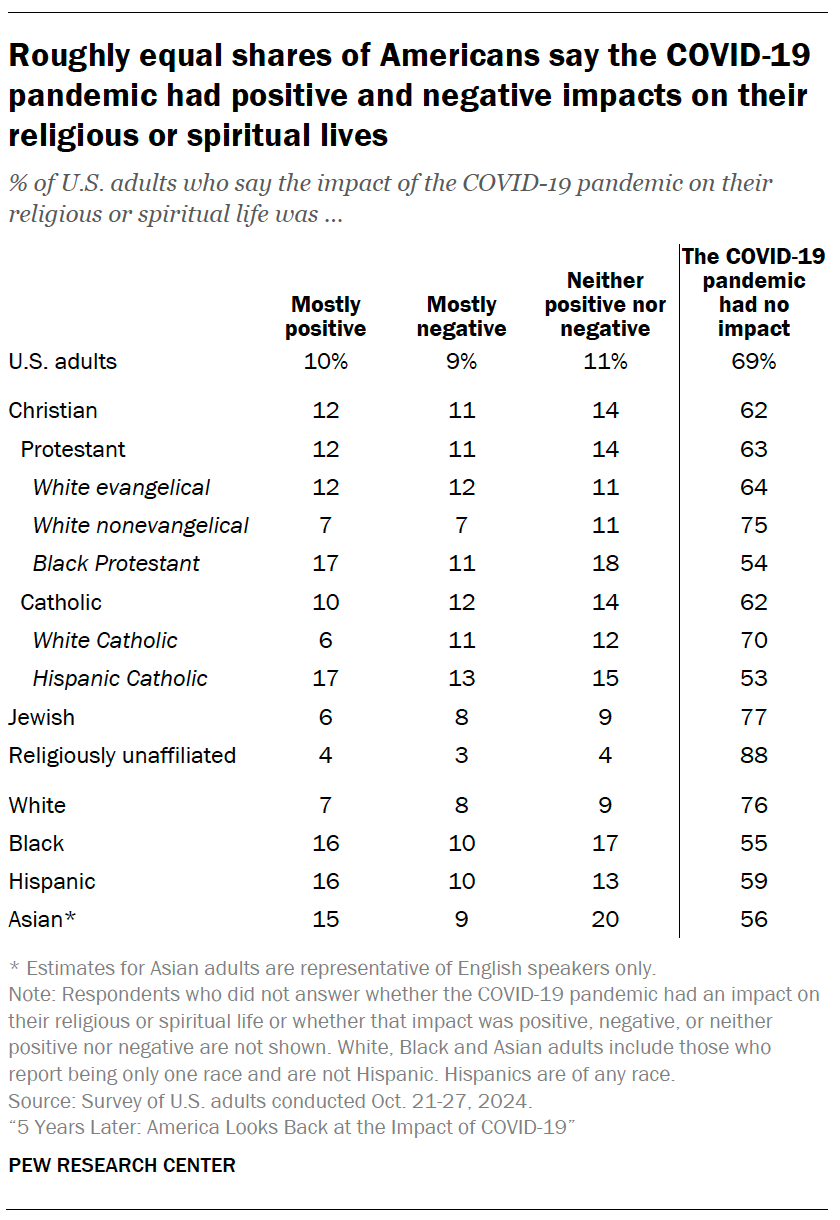
- Black Protestants are more likely to say the pandemic had a mostly positive impact on them than a mostly negative impact (17% vs. 11%).
- White Catholics are more likely to say the pandemic had a mostly negative impact than a mostly positive impact on them (11% vs. 6%).
When looking at race and ethnicity more broadly, Black, Hispanic and Asian Americans are somewhat more likely to say the pandemic had a mostly positive than a mostly negative impact on their religious or spiritual lives.
Roughly equal shares of White Americans say the pandemic’s effect on their religious or spiritual lives was mostly positive (7%) and mostly negative (8%).
Trends in religious service participation among religious and demographic subgroups
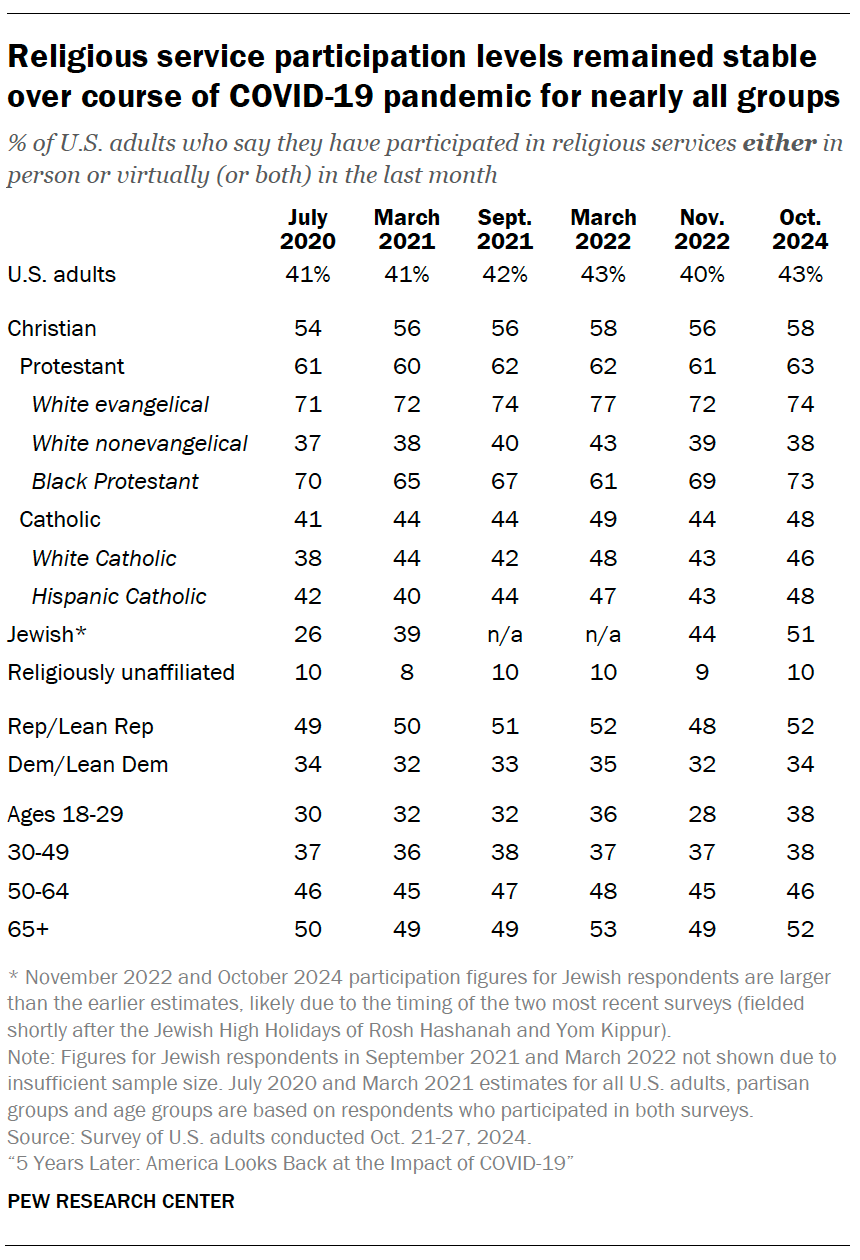
Throughout the pandemic, overall participation in religious services remained quite stable among most religious subgroups, most age groups and supporters of both major U.S. political parties. There are two notable exceptions:
- Religious service participation estimates for Jews are higher in the November 2022 and October 2024 surveys than they were in July 2020 and March 2021. This may reflect the timing of those surveys, which were fielded shortly after the Jewish High Holidays of Rosh Hashanah and Yom Kippur, a peak season for synagogue attendance.
- Among adults under 30, participation in religious services is somewhat higher in the latest survey (38%) than it was in July 2020 (30%). There has been a fair amount of fluctuation in the self-reported rates of attendance of Americans in this age group, which have been as low as 28% and as high as 38% since the start of the pandemic. Throughout this period, however, young adults (ages 18 to 29) have tended to participate in religious services much less often than those 65 and older, which was also the case before the coronavirus outbreak.

